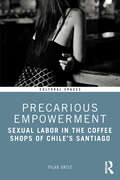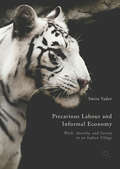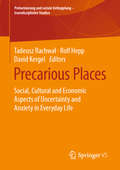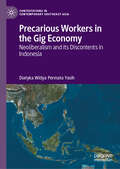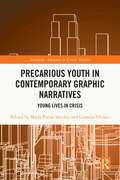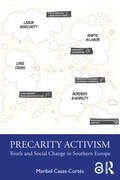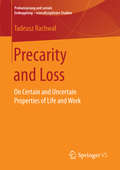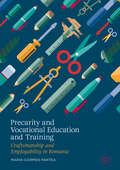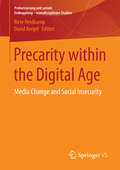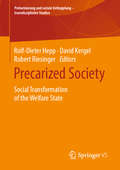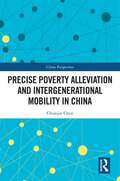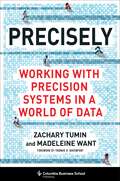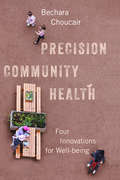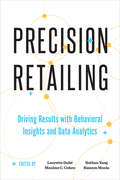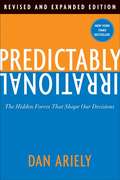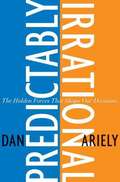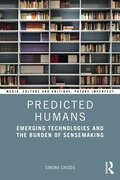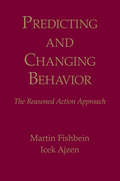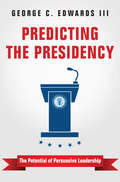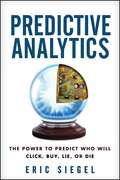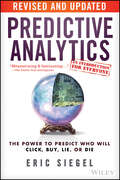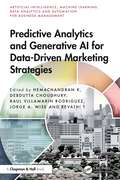- Table View
- List View
Precarious Empowerment: Sexual Labor in the Coffee Shops of Chile's Santiago (Cultural Spaces)
by Pilar OrtizPrecarious Empowerment: Sexual Labor in the Coffee Shops of Chile’s Santiago provides a textured and telling exploration into the lives and experiences of sex workers in Chile, their encounters with discrimination and economic precarity, and their empowered resistance.Set in and around ‘tinted cafes’—spaces hidden from public view where women dance for their male clients and perform sexual services—within Chile’s capital city of Santiago, author Pilar Ortiz traces connections between sex work in the present day and the lasting legacies of colonialism and gender and sexual norms. Drawing on her careful ethnographic observations and in-depth interviews with the workers and their clients, the book reveals the many challenges women face at the intersection of class, racial, and gender inequalities. It also documents their resistance to stigma and stifling social norms and predetermined gender roles. In their practice of sexual labor, the book argues that women display a considerable degree of agency, mobility, and empowerment. Within this contentious space, the author explores how sex workers negotiate inequalities and exclusion and how they are poised to do so in a rapidly changing political and social climate.Exploring experiences of exploitation and resistance within Chile, this book speaks to the much larger question of agency versus oppression in conversations about sexual labor worldwide. Its compelling analysis will captivate those interested in scholarly studies of sexual labor and the ways it is performed and shaped across hierarchies of race, class, and gender.
Precarious Labour and Informal Economy: Work, Anarchy, and Society in an Indian Village
by Smita YadavAn empirical account of one of India’s largest indigenous populations, this book tells the story of the Gonds—who currently face displacement and governmental control of the region’s forests, which has crippled their economy. Rather than protesting and calling for state intervention, the Gonds have turned toward an informal economy: they not only engage with flexible forms of work, but also bargain for higher wages and experience agency and autonomy. Smita Yadav conceives of this withdrawal from the state in favour of precarious forms of work as an expression of anarchy by this marginalized population. Even as she provides rich detail of the Gonds’ unusual working lives, which integrate work, labour, and debt practices with ideologies of family and society, Yadav illustrates the strength required to maintain dignity when a welfare state has failed.
Precarious Life: The Powers of Mourning and Violence
by Judith ButlerFive essays by Butler (rhetoric and comparative literature, U. of California-Berkeley) respond to the conditions of heightened vulnerability and aggression that followed the events of September 11, 2001. They reflect on explanation and exoneration; violence, mourning, and politics; indefinite detention; charges of anti-Semitism; and a non-violent ethics based on an understanding of how easily human life is annulled.
Precarious Lives: Waiting and Hope in Iran
by Shahram KhosraviIn Precarious Lives, Shahram Khosravi attempts to reconcile the paradoxes of Iranians' everyday life in the first decade of the twenty-first century. On the one hand, multiple circumstances of precarity give rise to a sense of hopelessness, shared visions of a futureless tomorrow, widespread home(land)lessness, intense individualism, and a growth of incivilities. On the other, daydreaming and hope, as well as civility and solidarity in political protests, street carnivals, and social movements, continue to persist. Young Iranians describe themselves as being stuck in purposelessness and forced to endure endless waiting, and they are also aware that they are perceived as unproductive and a burden on their society. Despite the aspirations and inspiration they possess, they find themselves forced into petrifying social and spatial immobility. Uncertainty in the present, a seemingly futureless tomorrow: these are the circumstances that Khosravi explores in Precarious Lives.Creating an intricate and moving portrait of contemporary Iranian life, Khosravi weaves together individual stories, government reports, statistics, and cultural analysis of art and literature to depict how Iranians react to the experience of precarity and the possibility of hope. Drawing on extensive ethnographic engagement with youth in Tehran and Isfahan as well as with migrant workers in rural areas, Khosravi examines the complexities and contradictions of everyday life in Iran. Precarious Lives is a vital work of contemporary anthropology that serves as a testament to the shared hardship and hope of the Iranian people.
Precarious Places: Social, Cultural and Economic Aspects of Uncertainty and Anxiety in Everyday Life (Prekarisierung und soziale Entkopplung – transdisziplinäre Studien)
by Rolf Hepp David Kergel Tadeusz RachwałThe book offers a cross-disciplinary perspective on various aspects of precariousness in contemporary culture and society, concentrating on the topographical aspects of sources and causes of uncertainty and anxiety. Precariousness and precarity are themselves provisional and uncertain categories, though ones inviting to rethinking the scopes of precarity and precariousness from the perspective of locality and of places involved in their otherwise global range. The recent years have shown some ways in which precarity has changed its status and has become a strongly debated area not only in economic and political disputes, but also in philosophical debates and various fields of research related to cultural studies. The articles included in the volume address the spatial scope of anxieties and uncertainties involving numerous men and women affected by the several decades of the neoliberal insistence on various kinds of flexibility which, in turn, has put in motion numerous new mechanisms of exclusion and marginalization. Apart from this, a historical view on the making of precarious places is also offered in the pages of the book.
Precarious Workers in the Gig Economy: Neoliberalism and its Discontents in Indonesia (Contestations in Contemporary Southeast Asia)
by Diatyka Widya Permata YasihThis book focuses on gig work and organising among gig workers in the Indonesian online transport service, situated within the context of widespread precaritisation and digitalisation in today’s world of work. It addresses the challenges experienced by precarious gig workers in Indonesia in articulating their struggles through the discourse of precarity. Such challenges are related to the reproduction of neoliberal-derived entrepreneurial aspirations amidst the historical relative absence of stable work patterns (previously associated with more advanced economies), and the historically rooted marginalisation of broad-based labour movements as a social force. Though showcasing the specific experiences of Indonesian workers, the analysis in this book is supplemented by broad comparative insights. It offers empirically based analysis for those interested in new forms of collective organisations and politics that emerge among workers under the imperatives of neoliberalism in Indonesia, and by extension Southeast Asia.
Precarious Youth in Contemporary Graphic Narratives: Young Lives in Crisis (Routledge Advances in Comics Studies)
by María Porras Sánchez Gerardo VilchesThis volume explores comics as examples of moral outrage in the face of a reality in which precariousness has become an inherent part of young lives. Taking a thematic approach, the chapters devote attention to the expression and representation of precarious subjectivities, as well as to the economic and professional precarity that characterizes comics creation and production. An international team of authors, young and senior systematically examines the representation of precarious youth in graphic fiction and autobiographic comics, superheroes and precarity, market issues and spaces of activism and vulnerability. With this structure, the book offers a global perspective and comprehensive coverage of different aspects of a complex and multifaceted field of knowledge, with a special attention to minorities and liminal subjects. The comics analyzed function as examples of "ethical solicitation" that bear witness of the precarious existence younger generations endure, while at the same time creating images that voice their outrage and might move readers to act. This timely and truly interdisciplinary volume will appeal to comics scholars and researchers in the areas of media and cultural studies, modern languages, education, art and design, communication studies, sociology, medical humanities and more.
Precarity Activism: Youth and Social Change in Southern Europe (Routledge Advances in Sociology)
by Maribel Casas-CortésActivist networks throughout Europe developed the concept of precarity at the turn of the 21st century. Retail chain employees, freelancers, cultural workers, caregivers and university adjuncts alike, including those labeled natives or migrants, identified and organized themselves under the umbrella notion of precarity. This ethnography tells the story of precarity activism as it originated and evolved in Southern Europe, tracing its theoretical and linguistic legacy. Highlighting the currency of precarity-inspired proposals for social change, this empirically detailed appraisal recapitulates activist debates over the prospects of flexible labor markets entangled with questions of gender and citizenship. The book’s analysis offers insight into how precarity activism’s visionary notions of sustainable futures speak directly to the tensions of the platform economy.This genealogy of a grassroots political concept will be of use for postgraduate students and scholars interested in anthropology, cultural studies, geography, sociology and political theory. It will appeal to interdisciplinary fields engaging processes of collective action, knowledge production and the so-called subaltern populations, such as social movements studies, gender studies, critical race and migration studies, dis/ability studies and labor studies. This book will further attract those concerned with changes in production, reproduction and mobility under platform capitalism as it further consolidates precarity as the new normal.The Open Access version of this book, available at http://www.taylorfrancis.com, has been made available under a Creative Commons Attribution-Non Commercial-No Derivatives (CC-BY-NC-ND) 4.0 license.
Precarity and Loss
by Tadeusz RachwałThe book is devoted, generally, to social andpolitical interdependencies of life and work, the interdependencies in whichthe ideas of loss and deprivation are the founding incentives of theprecariousness of the position and the status of human subject. Theanthropological idea of homo faber, ofman the artificer, which existentially links man with work has been complicatedby the rendition of the effects of work as properties which, in what HannahArendt calls "the rise of the social", have become inherently uncertain and perishable. Loss ofproperty in the economic sense, along with the loss of properties inepistemological terms have thus become a crucial measure of precarity anddissociated it from what Judith Butlercalls "the organization andprotection of bodily needs". The book offers a proposition of multidisciplinaryreading of the origins and constructions of "fear of loss" as a constitutivetrait of what may be called the "economization" of human condition, of ourpositioning of "life" away from its biological, or bodily, demands, ofascribing to it certain properties whose factual uncertainty. The book willconsists of an "Introduction" clarifying the senses in which the categories ofprecarity and loss are treated and discussed in different contexts. Its mainbody will consist of five chapters approaching the questions of precarity andloss from the perspective of a number of categories facilitating a betterunderstanding and readability of the complex networks within which somecertainty, frequently illusory, is projected upon otherwise fluid and uncertainflows of the real.
Precarity and Vocational Education and Training: Craftsmanship and Employability in Romania
by Maria-Carmen PanteaThis book explores how the changing nature of work intersects with and influences young people’s views on their future. As an increasingly precarious service sector overtakes traditional industrial work, vocational education and training (VET) is held up as a panacea for poverty alleviation, youth unemployment and economic growth. However, the views of young people in VET themselves concerning their own work and aspirations have largely been ignored. Based on interviews and focus groups conducted with over 250 young people in VET in Romania, this book examines the types of subjectivities that are generated in the processes by which they try to make sense of future and the meanings of work. In doing so, the author identifies three ideological layers that frame their views: arguing that while the young people interviewed hold ‘conventional’ aspirations for stability and predictability; they were visibly influenced by neoliberal beliefs in agency, experimentation and short termism. Ultimately, a layer of low expectations crystallises unvoiced concerns over a troubling future. In highlighting young people’s voices, this pioneering book calls for a recalibration of the emphasis on VET in Romania. It will appeal to students and scholars of youth studies, the sociology of work, vocational education and training and European studies.
Precarity within the Digital Age
by David Kergel Birte HeidkampThe book deals with precarity within the digital age and focuses on media change and social insecurity. Change arising from digital developments takes place on micro-, meso- and meta-levels and have always social implications. Concepts such as Social Media, eHealth and Digital Capitalism, Informational Capitalism and Social Exclusion, Digital Globalization and Motility frame the social dynamics and implications of changes in digital media. These changes evoke a double precarity or stable unstability: Social practices throughout the diverse societal fields are questioned through the media change which leads to a digital age. The ongoing media change requires new social practices - what evokes precarity as an ongoing insecurity how to face the `new digital world#65533;. As a socio-economic phenomenon and effect of neoliberal policy precarity changes life planning and self-narrations of the affected individuals. Precarity and neoliberal subjection-processes manifest in the digital age and are performatively re-produced by the way new media are used.
Precarized Society: Social Transformation of the Welfare State (Prekarisierung und soziale Entkopplung – transdisziplinäre Studien)
by Robert Riesinger David Kergel Rolf-Dieter HeppThis book provides international and transdisciplinary perspectives on Hyperprecarity and Social Structural Transformations in European Societies, USA and Russia enforced through other special transformation processes such as digitalisation, migration and demographic change. It has been observed that precarity and social insecurity do not refer any longer only to certain groups of the society such as unemployed people or to those ones who are ‘traditionally’ more in need of social benefit etc. but it accompanies and affects greater parts of the society, particularly those sections of the middleclass who conceive their social identity merely via their work ethics. Consequentially new forms of social exclusion are being producing taxing the traditional social cohesion in European societies due to the demand of new forms of flexibility and mobility from the working people. This process can be termed with the notion 'Hyperprecarisation'.This book contains contributions from scientists all over Europe, Russia and the USA, who are members of the SUPI network “Social Uncertainty, Prequarity, Inequality”.PD Dr. Rolf Hepp teaches at the Institut for Soziologie at the FU Berlin and coordinates the S.U.P.I.-Network.Dr. David Kergel teaches at Universität Siegen, Medienwissenschaftliches Seminar.Dr. Robert Riesinger, (Prof. a.D., FH Joanneum Graz) is author and researcher for sociology in Steyerberg.
Precise Poverty Alleviation and Intergenerational Mobility in China (China Perspectives)
by Chunjin ChenThe widening of income and wealth inequality has become one of the most important obstacles on the road to China’s common prosperity. In the context of inequality reduction and anti-poverty strategy in China, this book investigates the complex relationship between education and intergenerational mobility in terms of occupation and income. Based on large-scale social survey data, cutting-edge econometric models and statistical methods, the book examines the role of education in breaking the intergenerational transmission of poverty and promoting intergenerational mobility. It analyzes the characteristics of birth cohorts in intergenerational mobility, the long-term trends of educational, occupational, and income mobility among rural and urban residents across generations, and also the different regional patterns of intergenerational mobility against the background of social changes in China. Based on empirical findings, the author advances suggestions on an education policy conducive to poverty alleviation. The book will appeal to scholars and students studying the sociology of education, the economics of education and Chinese education, as well as policy makers interested in the topics of education policy systems and poverty alleviation, as well as education equity and social mobility.
Precisely: Working with Precision Systems in a World of Data
by Zachary Tumin Madeleine WantIf you want to win an election, improve the health of a city, or thrill your customers, you’re going to need precision systems—the highly engineered working arrangements of teams, processes, and technologies that put data and AI to work creating the change that leaders want, exactly how they want it. Big Tech firms like Amazon, Google, Apple, and Facebook have mastered their own precision systems, building trillion-dollar businesses using data-driven tools from mass-market “nudges” to industrial-grade recommendation systems.Precisely is the playbook for the rest of us. Zachary Tumin and Madeleine Want show how leaders in every domain are taking real-time precision systems into the marketplace, the political race, and the fight for health—from New York-Presbyterian Hospital to the New York Times, the NFL’s Baltimore Ravens to BNSF Railroad, the Biden-Harris campaign to the NYPD—to reveal elusive patterns, perform a repetitive task, run a play, or tailor a message, one at a time or by the millions.Precisely provides insight that will help leaders choose the system that’s right for them, decide which problem to tackle first, sell the importance of precision to stakeholders, power-up the people and the technology, and accomplish change that delivers precisely what’s needed every time—and do it all responsibly.
Precision Community Health: Four Innovations for Well-being
by Bechara ChoucairWhen Bechara Choucair was a young doctor, he learned an important lesson: treating a patient for hypothermia does little good if she has to spend the next night out in the freezing cold. As health commissioner of Chicago, he was determined to address the societal causes of disease and focus the city's resources on its most vulnerable populations. That targeted approach has led to dramatic successes, such as lowering rates of smoking, teen pregnancy, breast cancer mortalities, and other serious ills.In Precision Community Health, Choucair shows how those successes can be replicated and expanded around the country. The key is to use advanced technologies to identify which populations are most at risk for specific health threats and avert crises before they begin. Big data makes precision community health possible. But in our increasingly complex world, we also need new strategies for developing effective coalitions, media campaigns, and policies. This book showcases four innovations that move public health departments away from simply dispensing medical care and toward supporting communities to achieve true well-being.The approach Choucair pioneered in Chicago requires broadening our thinking about what constitutes public health. It is not simply about access to a doctor, but access to decent housing, jobs, parks, food, and social support. It also means acknowledging that a one-size-fits-all strategy may exacerbate inequities. By focusing on those most in need, we create an agenda that is simultaneously more impactful and more achievable. The result is a wholesale change in the way public health is practiced and in the well-being of all our communities.
Precision Retailing: Driving Results with Behavioral Insights and Data Analytics (Behaviorally Informed Organizations)
by Laurette Dubé Maxime C. Cohen Nathan Yang Bassem MonlaWithout a doubt, the COVID-19 era has forced the retail sector to rethink the way it conducts business. Customer experience has largely shifted into the digital realm, and questions have emerged about how to best optimize and evolve business operations in light of this change. Drawing on a host of expert contributors, Precision Retailing takes a broad perspective on precision retailing as the interaction point between individuals and the organizations, institutions, systems, and policies that support them in ever-changing contexts. The book assembles precision retailing key concepts, methods, and tools that complement existing behavioral research. The decision support tools will help managers better capture in real time the multiscale drivers of consumer behavior and successfully integrate these into their retail strategy and tactics. Each chapter includes a short strategic brief for successful human-centered digital transformation that focuses squarely on actionable insights for practitioners. Shedding light on the way we understand and handle this complex customer journey, Precision Retailing examines how retail will evolve in the post-COVID era, shaping how businesses meet the inevitable continuation of the digital transition.
Predict and Surveil: Data, Discretion, and the Future of Policing
by Sarah BrayneThe scope of criminal justice surveillance has expanded rapidly in recent decades. At the same time, the use of big data has spread across a range of fields, including finance, politics, healthcare, and marketing. While law enforcement's use of big data is hotly contested, very little is known about how the police actually use it in daily operations and with what consequences.
Predictably Irrational, Revised and Expanded Edition: The Hidden Forces That Shape Our Decisions
by Dr Dan Ariely"A marvelous book… thought provoking and highly entertaining." —Jerome Groopman, New York Times bestselling author of How Doctors Think "Ariely not only gives us a great read; he also makes us much wiser." —George Akerlof, 2001 Nobel Laureate in Economics "Revolutionary." —New York Times Book Review Why do our headaches persist after we take a one-cent aspirin but disappear when we take a fifty-cent aspirin? Why do we splurge on a lavish meal but cut coupons to save twenty-five cents on a can of soup?When it comes to making decisions in our lives, we think we're making smart, rational choices. But are we?In this newly revised and expanded edition of the groundbreaking New York Times bestseller, Dan Ariely refutes the common assumption that we behave in fundamentally rational ways. From drinking coffee to losing weight, from buying a car to choosing a romantic partner, we consistently overpay, underestimate, and procrastinate. Yet these misguided behaviors are neither random nor senseless. They're systematic and predictable—making us predictably irrational.
Predictably Irrational: The Hidden Forces That Shape Our Decisions
by Dan ArielyWe all think we make smart, rational choices, right? Ariely explains how expectations, emotions, social norms, and other invisible forces skew our reasoning abilities. Not only do we make astonishingly simple mistakes, we make the same types of mistakes. We consistently overpay, underestimate, and procrastinate. We fail to understand the profound effects of our emotions on what we want, and we overvalue what we already own. Yet these misguided behaviors are neither random nor senseless. They're systematic and predictable, making us predictably irrational. Ariely explains how to break through these patterns of thought to make better decisions.
Predicted Humans: Emerging Technologies and the Burden of Sensemaking (Media, Culture and Critique: Future Imperfect)
by Simona ChiodoPredicting our future as individuals is central to the role of much emerging technology, from hiring algorithms that predict our professional success (or failure) to biomarkers that predict how long (or short) our healthy (or unhealthy) life will be. Yet, much in Western culture, from scripture to mythology to philosophy, suggests that knowing one’s future may not be in the subject’s best interests and might even lead to disaster. If predicting our future as individuals can be harmful as well as beneficial, why are we so willing to engage in so much prediction, from cradle to grave?This book offers a philosophical answer, reflecting on seminal texts in Western culture to argue that predicting our future renders much of our existence the automated effect of various causes, which, in turn, helps to alleviate the existential burden of autonomously making sense of our lives in a more competitive, demanding, accelerated society. An exploration of our tendency in a technological era to engineer and so rid ourselves of that which has hitherto been our primary reason for being – making life plans for a successful future, while faced with epistemological and ethical uncertainties – Predicted Humans will appeal to scholars of philosophy and social theory with interests in questions of moral responsibility and meaning in an increasingly technological world.
Predicting and Changing Behavior: The Reasoned Action Approach
by Martin Fishbein Icek AjzenThis book describes the reasoned action approach, an integrative framework for the prediction and change of human social behavior. It provides an up-to-date review of relevant research, discusses critical issues related to the reasoned action framework, and provides methodological and conceptual tools for the prediction and explanation of social behavior and for designing behavior change interventions.
Predicting the Presidency: The Potential of Persuasive Leadership
by George C. Edwards IIIMillions of Americans—including many experienced politicians—viewed Barack Obama through a prism of high expectations, based on a belief in the power of presidential persuasion. Yet many who were inspired by candidate Obama were disappointed in what he was able to accomplish once in the White House. They could not understand why he often was unable to leverage his position and political skills to move the public and Congress to support his initiatives. Predicting the Presidency explains why Obama had such difficulty bringing about the change he promised, and challenges the conventional wisdom about presidential leadership. In this incisive book, George Edwards shows how we can ask a few fundamental questions about the context of a presidency—the president's strategic position or opportunity structure—and use the answers to predict a president's success in winning support for his initiatives. If presidential success is largely determined by a president's strategic position, what role does persuasion play? Almost every president finds that a significant segment of the public and his fellow partisans in Congress are predisposed to follow his lead. Others may support the White House out of self-interest. Edwards explores the possibilities of the president exploiting such support, providing a more realistic view of the potential of presidential persuasion. Written by a leading presidential scholar, Predicting the Presidency sheds new light on the limitations and opportunities of presidential leadership.
Predictive Analytics
by Thomas H. Davenport Eric Siegel"The Freakonomics of big data."--Stein Kretsinger, founding executive of Advertising.com; former lead analyst at Capital OneThis book is easily understood by all readers. Rather than a "how to" for hands-on techies, the book entices lay-readers and experts alike by covering new case studies and the latest state-of-the-art techniques.You have been predicted -- by companies, governments, law enforcement, hospitals, and universities. Their computers say, "I knew you were going to do that!" These institutions are seizing upon the power to predict whether you're going to click, buy, lie, or die.Why? For good reason: predicting human behavior combats financial risk, fortifies healthcare, conquers spam, toughens crime fighting, and boosts sales.How? Prediction is powered by the world's most potent, booming unnatural resource: data. Accumulated in large part as the by-product of routine tasks, data is the unsalted, flavorless residue deposited en masse as organizations churn away. Surprise! This heap of refuse is a gold mine. Big data embodies an extraordinary wealth of experience from which to learn.Predictive analytics unleashes the power of data. With this technology, the computer literally learns from data how to predict the future behavior of individuals. Perfect prediction is not possible, but putting odds on the future -- lifting a bit of the fog off our hazy view of tomorrow -- means pay dirt.In this rich, entertaining primer, former Columbia University professor and Predictive Analytics World founder Eric Siegel reveals the power and perils of prediction:What type of mortgage risk Chase Bank predicted before the recession.Predicting which people will drop out of school, cancel a subscription, or get divorced before they are even aware of it themselves.Why early retirement decreases life expectancy and vegetarians miss fewer flights.Five reasons why organizations predict death, including one health insurance company.How U.S. Bank, European wireless carrier Telenor, and Obama's 2012 campaign calculated the way to most strongly influence each individual.How IBM's Watson computer used predictive modeling to answer questions and beat the human champs on TV's Jeopardy!How companies ascertain untold, private truths -- how Target figures out you're pregnant and Hewlett-Packard deduces you're about to quit your job.How judges and parole boards rely on crime-predicting computers to decide who stays in prison and who goes free.What's predicted by the BBC, Citibank, ConEd, Facebook, Ford, Google, IBM, the IRS, Match.com, MTV, Netflix, Pandora, PayPal, Pfizer, and Wikipedia. A truly omnipresent science, predictive analytics affects everyone, every day. Although largely unseen, it drives millions of decisions, determining whom to call, mail, investigate, incarcerate, set up on a date, or medicate.Predictive analytics transcends human perception. This book's final chapter answers the riddle: What often happens to you that cannot be witnessed, and that you can't even be sure has happened afterward -- but that can be predicted in advance?Whether you are a consumer of it -- or consumed by it -- get a handle on the power of Predictive Analytics.
Predictive Analytics
by Eric Siegel"Mesmerizing & fascinating..." --The Seattle Post-Intelligencer "The Freakonomics of big data." --Stein Kretsinger, founding executive of Advertising.com Award-winning | Used by over 30 universities | Translated into 9 languages An introduction for everyone. In this rich, fascinating -- surprisingly accessible -- introduction, leading expert Eric Siegel reveals how predictive analytics works, and how it affects everyone every day. Rather than a "how to" for hands-on techies, the book serves lay readers and experts alike by covering new case studies and the latest state-of-the-art techniques. Prediction is booming. It reinvents industries and runs the world. Companies, governments, law enforcement, hospitals, and universities are seizing upon the power. These institutions predict whether you're going to click, buy, lie, or die. Why? For good reason: predicting human behavior combats risk, boosts sales, fortifies healthcare, streamlines manufacturing, conquers spam, optimizes social networks, toughens crime fighting, and wins elections. How? Prediction is powered by the world's most potent, flourishing unnatural resource: data. Accumulated in large part as the by-product of routine tasks, data is the unsalted, flavorless residue deposited en masse as organizations churn away. Surprise! This heap of refuse is a gold mine. Big data embodies an extraordinary wealth of experience from which to learn. Predictive Analytics unleashes the power of data. With this technology, the computer literally learns from data how to predict the future behavior of individuals. Perfect prediction is not possible, but putting odds on the future drives millions of decisions more effectively, determining whom to call, mail, investigate, incarcerate, set up on a date, or medicate. In this lucid, captivating introduction -- now in its Revised and Updated edition -- former Columbia University professor and Predictive Analytics World founder Eric Siegel reveals the power and perils of prediction: What type of mortgage risk Chase Bank predicted before the recession. Predicting which people will drop out of school, cancel a subscription, or get divorced before they even know it themselves. Why early retirement predicts a shorter life expectancy and vegetarians miss fewer flights. Five reasons why organizations predict death -- including one health insurance company. How U.S. Bank and Obama for America calculated -- and Hillary for America 2016 plans to calculate -- the way to most strongly persuade each individual. Why the NSA wants all your data: machine learning supercomputers to fight terrorism. How IBM's Watson computer used predictive modeling to answer questions and beat the human champs on TV's Jeopardy! How companies ascertain untold, private truths -- how Target figures out you're pregnant and Hewlett-Packard deduces you're about to quit your job. How judges and parole boards rely on crime-predicting computers to decide how long convicts remain in prison. 182 examples from Airbnb, the BBC, Citibank, ConEd, Facebook, Ford, Google, the IRS, LinkedIn, Match.com, MTV, Netflix, PayPal, Pfizer, Spotify, Uber, UPS, Wikipedia, and more. How does predictive analytics work? This jam-packed book satisfies by demystifying the intriguing science under the hood. For future hands-on practitioners pursuing a career in the field, it sets a strong foundation, delivers the prerequisite knowledge, and whets your appetite for more. A truly omnipresent science, predictive analytics constantly affects our daily lives. Whether you
Predictive Analytics and Generative AI for Data-Driven Marketing Strategies (Artificial Intelligence, Machine Learning, Data Analytics and Automation for Business Management)
by Hemachandran K Raul Villamarin Rodriguez Debdutta Choudhury Jorge A. Wise Revathi TIn providing an in-depth exploration of cutting-edge technologies and how they are used to support data-driven marketing strategies and empower organizations to make the right decisions, Predictive Analytics and Generative AI for Data-Driven Marketing Strategies includes real-world case studies and examples from diverse marketing domains. This book demonstrates how predictive analytics and generative AI have been successfully applied to solve marketing challenges and drive tangible results. This book showcases emerging trends in predictive analytics and generative AI for marketing, and their potential impact on the future of data-driven marketing. This book is meant for professionals and scholars to gather the skills and resources to use predictive analytics and generative AI effectively for marketing strategies.This book: • Examines the different predictive analytics models and algorithms, such as regression analysis, decision trees, and neural networks, and demonstrates how they may be utilized to get insightful conclusions from marketing data.• Includes generative AI techniques, such as generative adversarial networks (GANs) and variational autoencoders (VAEs), showcasing how these techniques can generate synthetic data for marketing insights and decision-making.• Highlights the importance of data-driven marketing choices and illustrates how generative AI and predictive analytics may be quite useful in this context.• Integrates the principles of data science with marketing concepts, offering a cohesive understanding of how predictive analytics and generative AI can power data-driven marketing decisions.• Presents the recent advances in predictive analytics and generative AI and discusses how they can affect the area of data-driven marketing.
